Radosław Kotaba
Control Aspects for Using RIS in Latency-Constrained Mobile Edge Computing
Dec 19, 2023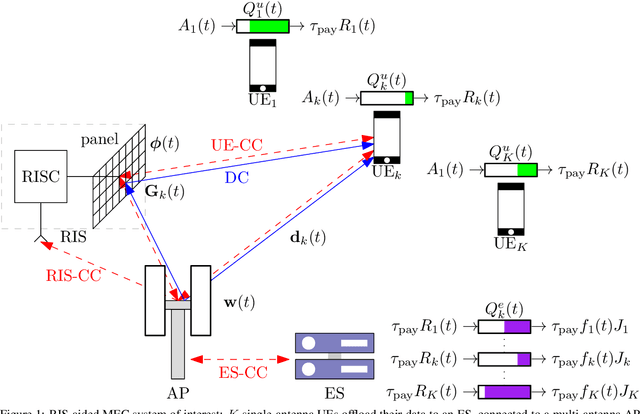
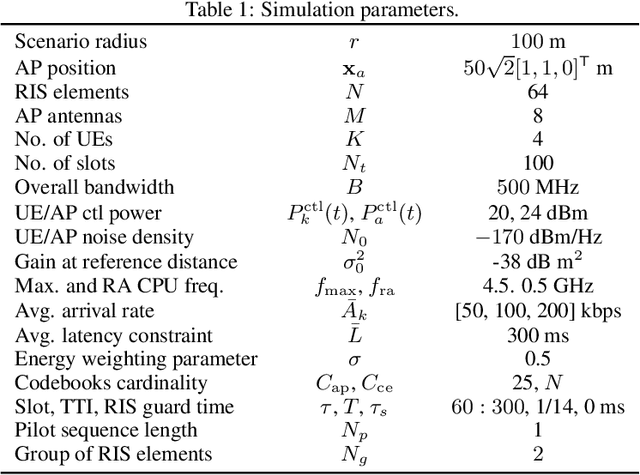
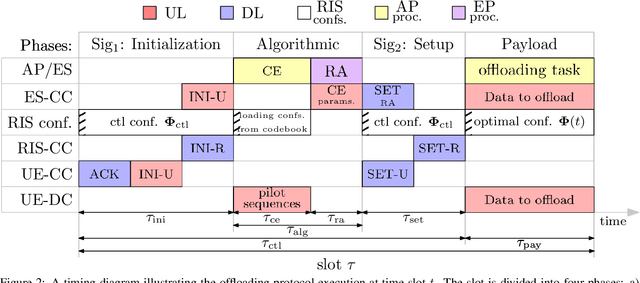
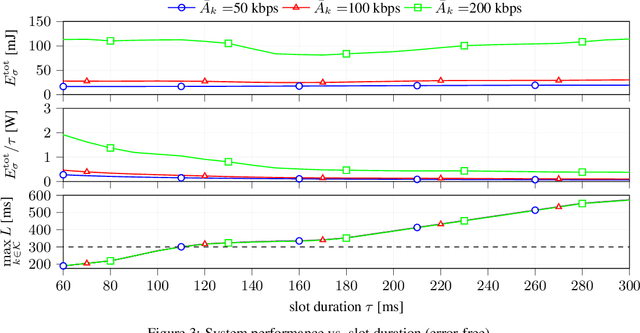
Abstract:This paper investigates the role and the impact of control operations for dynamic mobile edge computing (MEC) empowered by Reconfigurable Intelligent Surfaces (RISs), in which multiple devices offload their computation tasks to an access point (AP) equipped with an edge server (ES), with the help of the RIS. While usually ignored, the control aspects related to channel estimation (CE), resource allocation (RA), and control signaling play a fundamental role in the user-perceived delay and energy consumption. In general, the higher the resources involved in the control operations, the higher their reliability; however, this introduces an overhead, which reduces the number of resources available for computation offloading, possibly increasing the overall latency experienced. Conversely, a lower control overhead translates to more resources available for computation offloading but impacts the CE accuracy and RA flexibility. This paper establishes a basic framework for integrating the impact of control operations in the performance evaluation of the RIS-aided MEC paradigm, clarifying their trade-offs through theoretical analysis and numerical simulations.
EMF Exposure Mitigation in RIS-Assisted Multi-Beam Communications
May 11, 2023Abstract:This paper proposes a method for reducing {third-party} exposure to electromagnetic fields (EMF) by exploiting the capability of a reconfigurable intelligent surfaces' (RIS) to manipulate the electromagnetic environment. We consider users capable of multi-beam communication, such that a user can use a set of different propagation paths enabled by the RIS. The optimization objective is to find propagation alternatives that allow to maintain the target quality of service while minimizing the level of EMF at surrounding non-intended users (NUEs). We provide an evolutionary heuristic solution based on Genetic Algorithm (GA) for power equalization and multi-beam selection of a codebook at the Base Station. Our results show valuable insights into how RIS-assisted multi-beam communications can mitigate EMF exposure with minimal degradation of the spectral efficiency.
Uplink Multiplexing of eMBB/URLLC Services Assisted by Reconfigurable Intelligent Surfaces
May 08, 2023Abstract:Reconfigurable intelligent surfaces (RISs) with their potential of enabling a programmable environment comprise a promising technology to support the coexistence of enhanced mobile broadband (eMBB) and ultra-reliable-low-latency communication (URLLC) services. In this paper, we propose a RIS-assisted scheme for multiplexing hybrid eMBB-URLLC uplink traffic. Specifically, the scheme relies on the computation of two RIS configurations, given that only eMBB channel state information (CSI) is available. The first configuration optimizes the eMBB quality of service, while the second one mitigates the eMBB interference in the URLLC traffic. Analyzing the outage probability achieved by the scheme, we demonstrate that a RIS can improve the reliability of URLLC transmissions even in the absence of URLLC CSI.
A Framework for Control Channels Applied to Reconfigurable Intelligent Surfaces
Mar 29, 2023



Abstract:The research on Reconfigurable Intelligent Surfaces (RISs) has dominantly been focused on physical-layer aspects and analyses of the achievable adaptation of the propagation environment. Compared to that, the questions related to link/MAC protocol and system-level integration of RISs have received much less attention. This paper addresses the problem of designing and analyzing control/signaling procedures, which are necessary for the integration of RISs as a new type of network element within the overall wireless infrastructure. We build a general model for designing control channels along two dimensions: i) allocated bandwidth (in-band and out-of band) and ii) rate selection (multiplexing or diversity). Specifically, the second dimension results in two transmission schemes, one based on channel estimation and the subsequent adapted RIS configuration, while the other is based on sweeping through predefined RIS phase profiles. The paper analyzes the performance of the control channel in multiple communication setups, obtained as combinations of the aforementioned dimensions. While necessarily simplified, our analysis reveals the basic trade-offs in designing control channels and the associated communication algorithms. Perhaps the main value of this work is to serve as a framework for subsequent design and analysis of various system-level aspects related to the RIS technology.
Random Access Protocol with Channel Oracle Enabled by a Reconfigurable Intelligent Surface
Oct 09, 2022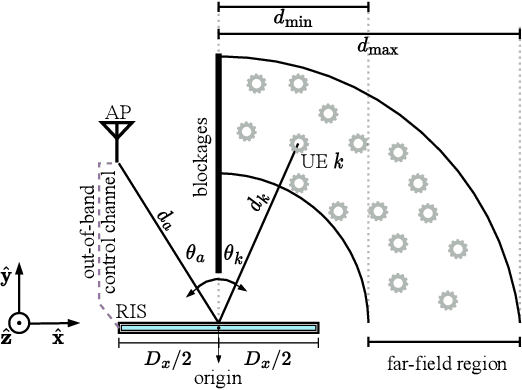



Abstract:The widespread adoption of Reconfigurable Intelligent Surfaces (RISs) in future practical wireless systems is critically dependent on the design and implementation of efficient access protocols, an issue that has received less attention in the research literature. In this paper, we propose a grant-free random access (RA) protocol for a RIS-assisted wireless communication setting, where a massive number of users' equipment (UEs) try to access an access point (AP). The proposed protocol relies on a channel oracle, which enables the UEs to infer the best RIS configurations that provide opportunistic access to UEs. The inference is based on a model created during a training phase with a greatly reduced set of RIS configurations. Specifically, we consider a system whose operation is divided into three blocks: i) a downlink training block, which trains the model used by the oracle, ii) an uplink access block, where the oracle infers the best access slots, and iii) a downlink acknowledgment block, which provides feedback to the UEs that were successfully decoded by the AP during access. Numerical results show that the proper integration of the RIS into the protocol design is able to increase the expected end-to-end throughput by approximately 40% regarding the regular repetition slotted ALOHA protocol.
 Add to Chrome
Add to Chrome Add to Firefox
Add to Firefox Add to Edge
Add to Edge